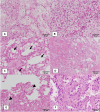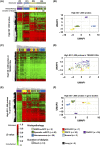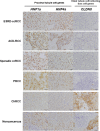Genetic and epigenetic profiling indicates the proximal tubule origin of renal cancers in end-stage renal disease
- PMID: 32860304
- PMCID: PMC7648048
- DOI: 10.1111/cas.14633
Genetic and epigenetic profiling indicates the proximal tubule origin of renal cancers in end-stage renal disease
Abstract
End-stage renal disease (ESRD) patients on dialysis therapy have a higher incidence of renal cell carcinomas (RCCs), which consist of 2 major histopathological types: clear-cell RCCs (ESRD-ccRCCs) and acquired cystic disease (ACD)-associated RCCs. However, their genetic and epigenetic alterations are still poorly understood. Here, we investigated somatic mutations, copy number alterations (CNAs), and DNA methylation profiles in 9 ESRD-ccRCCs and 7 ACD-associated RCCs to identify their molecular alterations and cellular origins. Targeted sequencing of 409 cancer-related genes, including VHL, PBRM1, SETD2, BAP1, KDM5C, MET, KMT2C (MLL3), and TP53, showed ESRD-ccRCCs harbored frequent VHL mutations, while ACD-associated RCCs did not. CNA analysis showed that ESRD-ccRCCs had a frequent loss of chromosome 3p while ACD-associated RCCs had a gain of chromosome 16. Beadarray methylation analysis showed that ESRD-ccRCCs had methylation profiles similar to those of sporadic ccRCCs, while ACD-associated RCCs had profiles similar to those of papillary RCCs. Expression analysis of genes whose expression levels are characteristic to individual segments of a nephron showed that ESRD-ccRCCs and ACD-associated RCCs had high expression of proximal tubule cell marker genes, while chromophobe RCCs had high expression of distal tubule cell/collecting duct cell marker genes. In conclusion, ESRD-ccRCCs and ACD-associated RCCs had mutation and methylation profiles similar to those of sporadic ccRCCs and papillary RCCs, respectively, and these 2 histopathological types of RCCs were indicated to have originated from proximal tubule cells of the nephron.
Keywords: ACD-RCC; epigenetics; hemodialysis; kidney cancer; renal cell carcinoma.
© 2020 The Authors. Cancer Science published by John Wiley & Sons Australia, Ltd on behalf of Japanese Cancer Association.
Conflict of interest statement
The authors declare no conflict of interest.
Figures





References
-
- Maisonneuve P, Agodoa L, Gellert R, et al. Cancer in patients on dialysis for end‐stage renal disease: an international collaborative study. Lancet. 1999;354:93‐99. - PubMed
-
- Stewart JH, Buccianti G, Agodoa L, et al. Cancers of the kidney and urinary tract in patients on dialysis for end‐stage renal disease: analysis of data from the United States, Europe, and Australia and New Zealand. J Am Soc Nephrol. 2003;14:197‐207. - PubMed
-
- Holley JL. Screening, diagnosis, and treatment of cancer in long‐term dialysis patients. Clin J Am Soc Nephrol. 2007;2:604‐610. - PubMed
-
- Kondo T, Sasa N, Yamada H, et al. Acquired cystic disease‐associated renal cell carcinoma is the most common subtype in long‐term dialyzed patients: central pathology results according to the 2016 WHO classification in a multi‐institutional study. Pathol Int. 2018;68:543‐549. - PubMed
MeSH terms
Grants and funding
LinkOut - more resources
Full Text Sources
Medical
Research Materials
Miscellaneous

